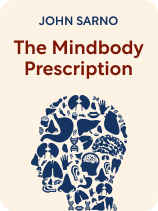

This article is an excerpt from the Shortform book guide to "The Mindbody Prescription" by John Sarno. Shortform has the world's best summaries and analyses of books you should be reading.
Like this article? Sign up for a free trial here.
What are the key elements of tension myositis syndrome? How and why does this condition develop?
Tension myositis syndrome, John Sarno’s theory, explains mindbody (or psychosomatic) pain as physical pain caused by repressed emotions. By understanding how this works, you can develop a better perspective on the potential causes of chronic pain.
Understand the core features of tension myositis syndrome and how a diagnosis can help you heal.
The Mindbody Connection: Tension Myositis Syndrome
Dr. John Sarno, physician and the author of The Mindbody Prescription, theorizes that many chronic pain disorders are different manifestations of the same mindbody disorder: tension myositis syndrome (or TMS). Tension myositis syndrome, John Sarno says, is a disorder in which mental, emotional, or psychological factors cause physical symptoms. He suggests that TMS is the single most common mindbody disorder in the Western world. (Shortform note: Other common mindbody disorders include hypertension, migraines, impotence, and dermatitis.)
(Shortform note: Some experts assert that not only can psychological factors cause immediate, noticeable symptoms of pain, but certain psychological symptoms can increase the risk of physical diseases: For example, they suggest that panic attack symptoms increase the likelihood of developing heart disease; depression can cause allergies; and schizophrenia can cause diabetes. This doesn’t mean that, for example, everyone with diabetes has schizophrenia—the implication is that diabetes is a physical ailment that’s particularly likely to develop as a result of schizophrenia.)
Modern medicine doesn’t currently recognize mindbody connection, and doctors are trained to view the mind and the body as separate. For this reason, doctors usually attribute chronic pain conditions to structural abnormalities—abnormalities in the physical structure of certain parts of the body, especially the spine. These abnormalities can come from injuries, congenital diseases, or the normal process of aging.
(Shortform note: The idea that the mind and body are separate is known as mind-body dualism, a concept often credited to 17th-century philosopher René Descartes. Prior to the popularization of this theory, the general view was that the mind and body were indistinguishable, in accordance with the orthodox Christian view at the time. This view also held that the body had to be intact for a person to go to heaven, meaning dissection of human bodies was taboo. Mind-body dualism enabled advancements in medicine by allowing for such dissection. However, some experts today suggest that clinging to the mind-body dualism model limits medical science and gives us a fractured view of health, one that disregards the role of the mind.)
Doctors gravitate toward structural diagnoses because they can clearly identify abnormalities through body scans like X-rays—but Sarno suggests that these abnormalities are extremely common and, in many people, aren’t directly responsible for pain. Furthermore, people who do have pain often find that their pain increases after they see evidence of an abnormality on a scan (suggesting a psychological connection). In other words, the presence of pain alongside a structural abnormality is frequently coincidental. In cases where doctors can’t identify a structural abnormality, they’ll still attribute the pain to a physical problem such as muscle weakness, injury, or inflammation.
(Shortform note: How can simply seeing an abnormality on a scan increase the pain you feel? In short, the way the body detects pain is complex and involves many different biological processes, meaning it can often misinterpret benign stimuli as threatening and send pain signals to alert you to its damaging potential. While a structural abnormality may not present a threat to your body, your brain will perceive it as such and increase your pain.)
Sarno suspected that the diagnoses of structural abnormalities were faulty because patients with these diagnoses often find that their treatment is ineffective at alleviating their pain. Sarno also explains that the body has incredible healing abilities: Any tissue that’s damaged—even the brain—can eventually heal itself, so ongoing pain with no clear physiologic cause makes no sense.
Through his work with patients suffering from such pain, Sarno concluded that muscle was the main tissue involved in TMS conditions, particularly the muscles in the neck, shoulders, back, and buttocks. However, he still couldn’t find a clear physiologic cause.
| How Accepting a TMS Diagnosis Could Relieve Pain Research supports the idea that your psychological state and perception of pain can affect its intensity: Namely, your emotions, expectation of pain, and the attention you pay to the pain can make it feel more or less severe. For example: 1. If you’re exposed to painful stimuli while experiencing negative emotions, that pain will feel more intense than the pain the same stimuli would evoke when you’re experiencing positive emotions. 2. If you expect to experience pain from a stimulus, this will also result in more pain than if you expect it to be pain-free. 3. Finally, pain tends to be more severe when you focus your attention on it, while focusing your attention elsewhere can reduce feelings of pain. This could help explain the efficacy of Sarno’s method. Patients who accepted the diagnosis would likely feel more hopeful about the potential for eliminating their pain, and this positive emotion could provide immediate relief to their pain. Additionally, when patients accepted the idea that their pain came from tension, they likely shifted their attention from their physical pain to their psychological state, further reducing the pain they were experiencing. As we’ll see later in the guide, this attentional shift is essential to Sarno’s treatment method. |

———End of Preview———
Like what you just read? Read the rest of the world's best book summary and analysis of John Sarno's "The Mindbody Prescription" at Shortform.
Here's what you'll find in our full The Mindbody Prescription summary:
- A look at the chronic pain epidemic that's plaguing the Western world
- That the key to solving your pain is resolving your emotional tensions
- Why modern medicine doesn't recognize mindbody connection






